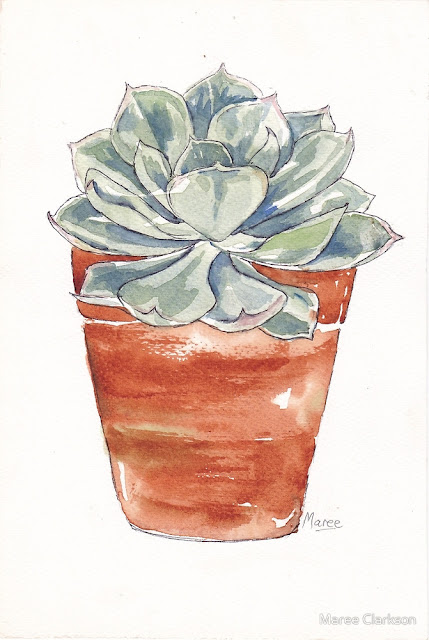I just love the cacti growing in my garden and here I've done a few quick ink sketches on note paper of them in pots and in my garden.
Echinopsis oxygona cactus
Black ink sketch and watercolour of a cactus in a pot in my garden (Tarlton, Gauteng, South Africa) on note paper
The
only cactus genus that is more confusing than Echinopsis is that of
Opuntia. In both cases, there is a great number of species (over 100)
and a tremendous amount of variation.
The main factor that ties these plants together are their very large,
showy flowers. These flowers are all very similar in structure – funnel
shaped, with hairy/wooly scaled floral tubes which give rise to hairy,
globular fruit filled with a soft, mushy pulp. The flowers seldom last
more than a single day and may be diurnal or nocturnal depending on the
species.
Sometimes known as hedgehog cactus, sea-urchin cactus or Easter lily cactus, Echinopsis is native to South America.
Opuntia - Prickly pear cactus
my cactus waits patiently for summer
stuffed into a pot by the window
rain or snow cactus sits meditating
so deep you would think asleep -
would be more fitting. but I know better
get too close and cactus is alive and willing
sharp as ever and prickly with it.
- nivek
Sand dollar catus
Astrophytum asterias (this is next on my list for my collection) –
a small, round, spineless cactus, up to 2.4 inches (6 cm) tall and up to
6 inches (15 cm) in diameter. The disc-shaped body is non-branched,
flat, dark green in colour, with 5 – 11 (generally 8) ribs. In the
middle of each rib there are woolly areoles. Native to small parts of
Texas in the United States and Mexico. Also known as Sea Urchin Cactus,
Star Cactus.
Cactus sunset - from my imagination
Guardian against sunset
the ancient cactus stands …
Trichocereus cactus
Trichocereus hybrids, sometimes called torch cacti, put on magnificent
displays of large, brilliant flowers. Collectors will throw impromptu
parties when all their plants bloom on the same day!
::






























